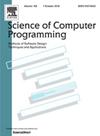在具有随机事件的矩形自动机中最大化到达概率
IF 1.4
4区 计算机科学
Q3 COMPUTER SCIENCE, SOFTWARE ENGINEERING
引用次数: 0
摘要
本文介绍了矩形自动机的两种随机变体。首先,本文介绍了具有随机事件的矩形自动机(RAE),它在语义上嵌入了随机事件。其次,在具有随机时钟的矩形自动机(RAC)中,随机事件的动态被明确地建模为秒表,这些秒表被称为随机时钟。我们证明,RAE 可以转化为 RAC,并保持有时间和跳跃限制的可达性。这两种建模变体都包含离散行为的时间诱导非确定性和动态行为的非确定性。RAE 和 RAC 的区别在于随机事件的建模:RAE 在语义上确保通过随机保护正确处理随机事件,而在 RAC 中,建模者有责任确保(例如)启用和禁用随机时钟,从而使所产生的随机延迟正确模拟所需的随机事件。然而,RAC 的优势在于,现有的非随机矩形自动机方法可直接应用于 RAC,以计算可达状态空间。然后,我们提出了一种算法,用于最大化 RAC 的可达性概率,并采用与历史相关的预言调度。具体来说,我们使用后向细化方法来确定最大预言调度器,并证明了所提方法的正确性。我们在一个可扩展模型上说明了所提方法的可行性,并用我们的工具 RealySt 计算出的结果与工具 ProHVer 进行了验证。本文章由计算机程序翻译,如有差异,请以英文原文为准。
Maximizing reachability probabilities in rectangular automata with random events
This paper introduces two stochastic variants of rectangular automata. First, rectangular automata with random events (RAE) are introduced, which semantically embed random events. Second, in rectangular automata with random clocks (RAC), the dynamics of random events are explicitly modeled as stopwatches which are called random clocks. We show that RAE can be transformed into RAC maintaining time- and jump-bounded reachability. Both modeling variants incorporate time-induced nondeterminism on discrete behavior and nondeterminism in the dynamic behavior. The difference between RAE and RAC lies in the modeling of the random events: while RAE semantically ensure that random events are correctly handled via stochastic guards, in RAC it is the responsibility of the modeler to ensure, e.g., that random clocks are enabled and disabled such that the resulting random delay correctly models the desired random event. However, the advantage of RAC is that existing methods for nonstochastic rectangular automata can directly be applied to RAC to compute the reachable state space. We then propose an algorithm to maximize reachability probabilities for RAC with history-dependent prophetic scheduling. Specifically, we use a backward refinement approach to identify the maximum prophetic scheduler and prove the correctness of the proposed method. The feasibility of the presented approach is illustrated on a scalable model and the results computed with our tool RealySt are validated against the tool ProHVer.
求助全文
通过发布文献求助,成功后即可免费获取论文全文。
去求助
来源期刊

Science of Computer Programming
工程技术-计算机:软件工程
CiteScore
3.80
自引率
0.00%
发文量
76
审稿时长
67 days
期刊介绍:
Science of Computer Programming is dedicated to the distribution of research results in the areas of software systems development, use and maintenance, including the software aspects of hardware design.
The journal has a wide scope ranging from the many facets of methodological foundations to the details of technical issues andthe aspects of industrial practice.
The subjects of interest to SCP cover the entire spectrum of methods for the entire life cycle of software systems, including
• Requirements, specification, design, validation, verification, coding, testing, maintenance, metrics and renovation of software;
• Design, implementation and evaluation of programming languages;
• Programming environments, development tools, visualisation and animation;
• Management of the development process;
• Human factors in software, software for social interaction, software for social computing;
• Cyber physical systems, and software for the interaction between the physical and the machine;
• Software aspects of infrastructure services, system administration, and network management.
 求助内容:
求助内容: 应助结果提醒方式:
应助结果提醒方式:


